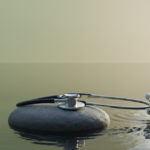For the last several years, burnout (a syndrome typically defined as emotional exhaustion, cynicism, and poor efficacy) has been a hot topic in the world of health care. But as a bit of good news, the AMA recently released that the rates of physician burnout are at the lowest they have been since the beginning of the COVID-19 pandemic. However, I would argue that if 43 percent of the physician community continue to experience these feelings, we still have work to do.
But why do we still need to care? Beyond it being optimal that people love their jobs, that is 40 percent of our physicians and colleagues who may be linked to low patient satisfaction, decreased quality of patient care, and a predictor of medical error. To counter burnout, organizations will need to continue to make strides to support their staff at an institutional level, but individuals should not underestimate the role we can play in maintaining our own mental health. And although people can recover from burnout, whenever possible, emphasis should be placed on prevention since it avoids the challenge of remediation.
To help physicians cultivate the skills to sustain their well-being throughout their careers, we need to provide strategies for burnout prevention and management resources as early in their careers as we can (whether as medical students up to attendings). This could lead to long-term payoffs for the medical community, patient care, and individuals on a personal level. The remainder of this article will focus on one tool we can use to bring mindfulness and moments of wellness into our daily routines.
The 10-10-10 prevention tool
Previous studies, such as this article, indicate that mindfulness curriculums in health professions education programs (medicine, dentistry, nursing, etc.) can reduce learners’ negative emotions and stress and increase empathy and compassion. These results have the potential to have a large impact on the day-to-day perceptions an individual has about their job and an individual’s ability to prevent burnout or improve their mental health overall.
With that in mind, the 10-10-10 Prevention Tool was designed to act as a forcing function for an individual to create a proverbial “menu” of mindful or protective actions that fit into three specific amounts of time. The intention behind writing out these lists and keeping them readily available is to remove the cognitive load of having to come up with mindful practices in stressful moments and subsequently make it easier to incorporate those customized actions into the everyday. Using this tool, the remaining barrier to practicing mindfulness is recognizing when there is the space to do so, which comes with practice.
- Actions in the “10 seconds” category aim to replicate moments such as right before an exam or before you enter a patient room. Examples might include box breathing, taking notice of your surroundings or body, or saying a mantra or prayer.
- Actions in the “10 minutes” category can be used in between obligations or during designated breaks. Examples might include taking a walk, closing your eyes, journaling, getting a snack, meditating, or prioritizing remaining tasks.
- Actions in the “10 hours” category represent a day completely (or mostly) away from work. Examples might include physical activities, catching up with friends or family, dedicating time to hobbies, or attending organized events.
Give it a try for yourself and come up with actions that resonate with you and your values. Try to include actions that realistically fit the specific constraints of your schedule, environment, and finances.

Broader applications
Initially, the 10-10-10 Prevention Tool was developed as an activity for medical students to be proactive about maintaining their well-being as the school year began, before they were thrust into a firehose of information and the thick of exams and patient care. However, this tool is customizable in two distinct ways that can broaden its potential applications. The first is that each individual can come up with their own strategies and decide what goes on their own lists. The second is that although the theme of the tool is mindfulness, the targeted outcome could vary from person to person. For example, this tool could be used by people in occupations outside of health care that can be demanding—whether law or retail—or for outcomes beyond burnout prevention, such as mitigating a stationary lifestyle, mindless eating, or other mental health concerns such as anxiety. The bottom line is that anyone who is looking to increase their mindfulness and presence could benefit from the 10-10-10 brainstorm activity.
The hope is that by highlighting this new tool, more individuals will specifically prioritize incorporating mindfulness to ensure that as providers, our cups are full enough to give to others what they deserve and act as an example for those around us including medical students, residents, and other members of our teams.
Disclaimer: The views expressed in this abstract are those of the author and do not reflect the official policy of the Uniformed Services University of the Health Sciences, Department of Health and Human Services, or Department of Defense.
Annabelle Bailey is a medical student.


















![Rebuilding the backbone of health care [PODCAST]](https://kevinmd.com/wp-content/uploads/Design-3-190x100.jpg)

![Understanding the cracked pot theory of a medical legacy [PODCAST]](https://kevinmd.com/wp-content/uploads/Design-4-190x100.jpg)
